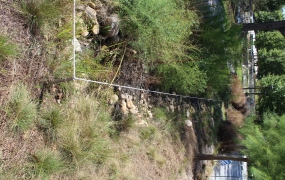The Kendeda Building for Innovative Sustainable Design is surrounded by an impressive amount of green space (40,237 square feet) - fitting for a Living Building. Every element of The Kendeda Building’s construction and operation challenged Georgia Tech to rethink how things are “always done,” and landscaping maintenance was no exception.
The Landscape Pilot Project
Per the International Living Future Institute, the organization that manages the Living Building Challenge, to achieve Living Building Challenge 3.1 certification, The Kendeda Building had to be designed to operate at a "net-positive energy and water and to maintain the landscape" without using the conventional methods of "pesticides and fertilizer but with native plants only.” To prepare for this element of the Living Building Challenge, a team, led by Georgia Tech Associate Director of Landscape Services and Fleet Services conducted a 12-month long pilot project to assess:
- Combustion-free maintenance equipment
- Weed, disease, and insect control without the use of petrochemical-based products
- Irrigation from only non-potable water sources
- Soil moisture monitoring
- Composting 100 percent of landscape waste
To understand the operational impacts of the certification, grounds located near the site of The Kendeda Building were subdivided into four test plots. Each of the plots were roughly equal in size, though there was some size variation. No special vegetation was brought into the test plots—what was already growing was what was tested. The test plots were surrounded by gravel, and this helped prevent (additional) weeds from migrating to the area.
The variables tested at the different plots were mechanical/hand weeding (weeding using strictly hand tools or just hands), battery-powered tools powered with rechargeable batteries, and the use of an organic herbicide to kill weeds.
The four test plots were maintained with the following, different standards:
- Plot 1: Control (no treatment or maintenance); flora was ornamental grass – 656 sq. ft.
- Plot 2: Mechanical/hand weeding only; flora was ornamental grass – 390 sq. ft.
- Plot 3: Mechanical/hand weeding and battery powered tools only; flora was ornamental grass – 485 sq. ft.
- Plot 4: Mechanical/hand weeding, battery powered tools, organic herbicide (Avenger Organic Weed Killer, an herbicide that uses concentrated citrul oil), and mulch; flora was ornamental grass, shrub, and Ball Cypress Tree – 860 sq. ft.
Additionally, two turf area treatment plots were maintained in the following methods:
- Plot 1: Battery powered mower, line trimmer, organic weed control/fertilizer – 480 sq. ft.
- Plot 2: Battery powered mower, line trimmer, no weed control, no fertilizer – 480 sq. ft.
Pushing through the Weeds
The intent of the pilot project was for Georgia Tech to develop a plan for how landscape services will operate on The Kendeda Building grounds. Atlanta receives both a lot of sunshine and plenty of rain—these factors combine to create an environment where plants grow quickly. Challenges the team encountered included:
- The selection of an effective organic herbicide;
- Staffing time realized when plots were maintained with hand tools versus traditional and battery powered tools; and
- Equipment failure.
The team discovered that Avenger Organics Weed Killer did not effectively kill weeds. As a result, more hand-weeding would be required, and a much broader variety of local and non-native plants may be able to propagate on the site. A weed is simply a plant that is not wanted in a specific location. Therefore, at The Kendeda Building, we had to be more accepting of a naturalized landscape, one that may include plants reminiscent of a wild meadow.
Rethinking our Process and Sharing What we Learned
Robert Paltz, a member of the Landscape team shared, “A challenge is just an opportunity to rethink things.” The findings by the team influenced decisions for The Kendeda Building landscaping. The most common messages discovered throughout this project were the importance of education and a willingness to rethink how we operate.
The landscaping at The Kendeda Building looks different than other landscaped areas of campus—a situation witnessed at site visits to other Living Buildings. It is necessary to address landscaping expectations and to educate the Georgia Tech community that the landscaping at The Kendeda Building looks different – by design – than other areas on campus. It cannot be said that one landscaping style is better than another; they are inherently different. Different appearances require different maintenance, and with differences come particular benefits and challenges. One clear benefit from this style of landscaping is that the area will be primed to be richer in wildlife and pollinators, raising the biodiversity on campus.
A specialized horticulturist was brought on to maintain The Kendeda Building site and is able to not only maintain the area but also to share on-going learnings and educational information to both visitors and other staff members.
Using this Information at Home
The findings of this project go past The Kendeda Building and into our homes. Organic and low environmental impact gardening practices are important and should be applied any time it is possible. It is actually easier to maintain a home or personal garden utilizing the above methods than it is to maintain a commercial area.
A few tips to incorporate as you are planning a more sustainable garden:
- Plant selection – carefully research and select the plants for your garden, remembering to consider sun-needs, migration tendencies, native plant selection, and maintenance needs.
- Mulch helps reduce the proliferation of weeds; mulch also needs to be periodically replaced as it breaks down into soil.
- Remember that you have to be committed to maintaining a landscape in this way – consistent and frequent weeding is necessary.
Links:
- Georgia Tech Facilities: Landscape Services http://facilities.gatech.edu/landscaping
- Georgia Tech Arboretum: http://arboretum.gatech.edu/
- Urban Honey Bee Project: http://www.bees.gatech.edu/






